June itinerary in Japan Day 1 (Osaka Meal edition)
(Wednesday, June 8)
Table of contents
1. Soraben
For breakfast on June 8, I had a “Soraben (Sky bento)” at Haneda Airport. This trip to Osaka/Kyoto has nothing to do with Fukuoka Prefecture, but I bought a “Yamaya Mentai Saizen” (Yen 1,350) from Fukuoka Prefecture.
-e1654996546923-300x300.jpg)
The “Yamaya Mentai Saizen” is one of the more expensive “Soraben” sold at Haneda Airport. However, when I opened the lid of the bento, I found that the coloring was very plain. I was disappointed after opening the lid, because I think coloring is very important for both “Ekiben” and “Soraben”. The taste was good, but it was not good enough to make up for the very plain coloring. Considering the price, I felt that it was a very overpriced “Soraben”. I knew I shouldn’t have bought a Fukuoka bento at Haneda Airport.
2-e1654996576974-300x300.jpg)
2. Okonomiyaki “Abeton”
After sightseeing at Shitennoji Temple, I had okonomiyaki at “Abeton“, which is located a little more than 5 minutes away on foot. “Abeton” is located in an underground shopping mall called “Abechika”. It is located on the Shitennoji Temple side of “Abechika“, so it is a very good location for an okonomiyaki restaurant to go to after sightseeing at Shitennoji Temple. I entered the restaurant around 11:20 and was able to easily find a seat, but by 11:30 the restaurant was already full.
I ordered “Beef tendon Ponzu” (Yen 500) and “Abeton Mix” (Yen 1,700 ) at “Abeton”. The beef tendon ponzu is made from very tender beef tendon, making it easy to eat and very refreshing and tasty. It is a good menu item to have before okonomiyaki.
2-e1654998105450-300x300.jpg)
“Abeton Mix” is an okonomiyaki with lots of ingredients such as seafood and meat. It was a very delicious okonomiyaki with lots of ingredients and a satisfying taste. In particular, they used a lot of yam for their okonomiyaki dough, and their stickiness and softness created a nice texture. It was completely different from the hard dough offered by many okonomiyaki restaurants outside of Osaka. Also, since the sauce was applied with a brush on the mayonnaise, mustard, and ketchup that was applied on top of the okonomiyaki, the taste of the seasoning was exquisitely integrated to add good taste. This style was new to me and impressed.
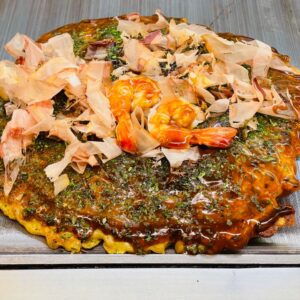
Abeton has been in business since 1970. It has been selected as one of the 100 best restaurants in Japan by “Tabelog”. Abeton is the originator of Modern-yaki and Negi-yaki. Next time I visit Abeton, I would like to try their modern-yaki and negiyaki.
Okonomiyaki was selected as a representative dish of Osaka in the “Local dishes loved by the nation” by the Ministry of Agriculture, Forestry and Fisheries of Japan, along with takoyaki. Both okonomiyaki and takoyaki are well-known throughout Japan, so they are famous to all people. However, I always eat okonomiyaki whenever I visit Osaka, especially because there tends to be a big difference in the softness of the dough between Osaka and non-Osaka okonomiyaki. The “Abeton” I went to this time was another okonomiyaki that I was very satisfied with.
3. Sushi “Abaraya”
I had dinner at “Abaraya” in Namba. It is conveniently located a 5-minute walk from Namba Station. Namba Grand kagetsu is a 2-minute walk away. Although “Abaraya” is conveniently located, it may be a little hard to find because of its location in a narrow alley.
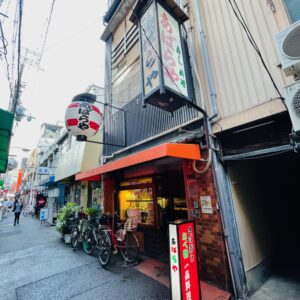
Abaraya is a long-established sushi restaurant established in 1955. The name “Abaraya” was chosen because the restaurant looked like “abaraya (shack)” when it was founded. The unpretentiousness typical of Osaka gives it a favorable impression.
The first thing that impressed me at Abaraya was the service set. The service set includes a draft beer, tsuki-dashi, assorted sashimi, and deep-fried tofu for only Yen 1,000. At such a low price, I was worried that the restaurant might go into the red. In the Kansai region, Otoshi (appetizers) are called tsuki-dashi and sashimi are called tsukuri.
The sashimi platter included red sea bream, greater amberjack, and octopus. Japan Fisheries Co-operative has selected “Naniwa no Madako” (season: June-October) as a summer “PRIDE FISH”. It is said that the name “Naniwa (Garden of fish)” originated from the name of a garden of fish, or a sea of abundance. I learned for the first time that “Naniwa (Garden of fish)” is the origin of the word “Naniwa” in the name of “PRIDE FISH”.
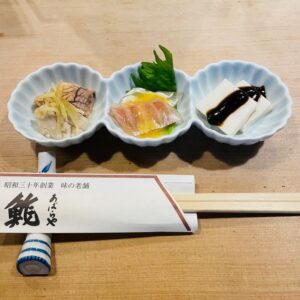
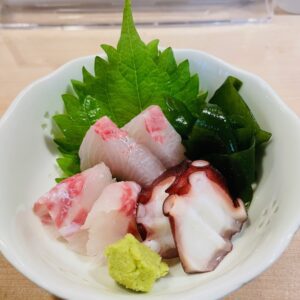
Next to the service set, I ordered “Grilled Sea Bass with Salt” and “Conger eel Ate”. The “Grilled Sea Bass with Salt” was Abaraya’s “Today’s Special”. Sea bass is in season from April to August, so I was able to enjoy it when it was fatty and delicious. Japan Fisheries Co-operative selects “Osaka sea bass” (season: July-September) as “PRIDE FISH” of summer.
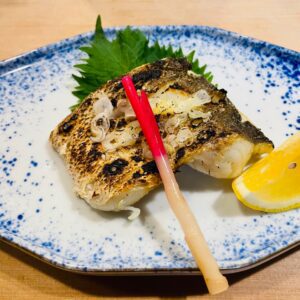
It was disappointing that the “Conger eel Ate” was not as meaty as it could have been. However, Japan Fisheries Co-operative has selected “Osaka conger eel” (season: April-June) as a “PRIDE FISH” of spring. The gastronome Kitaoji Rosanjin also wrote, “The best conger eel is found in the waters around Sakai. Next time, I would like to try thick-fleshed “Osaka conger eel”. The word “Ate” is mainly used in the Kansai region and means “side dish (relish)” or “snack.

My last meal at Abaraya was a half portion of their famous “mackerel sushi” (Yen 1,300 ). The mackerel sushi at “Abaraya” is made without vinegar, but only with salt. The mackerel sushi at Abaraya is made with only salt and no vinegar, which is said to concentrate the flavor of the mackerel. I like vinegar-pickled mackerel sushi, but I think I could enjoy the original taste of mackerel more because I could not smell or taste the vinegar in the mackerel sushi made with only salt. I was impressed by the great idea of using sansho (Japanese pepper) leaves to remove the smell of the mackerel and add the fresh aroma of sansho (Japanese pepper), as well as the beautiful coloring. The mackerel sushi looked and tasted fantastic.
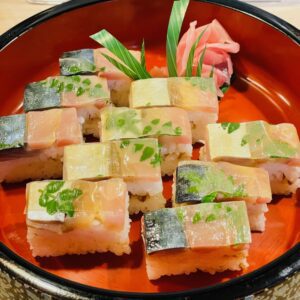
Pressed mackerel sushi is called “Battera”. “Battera” is the original Osaka-style sushi, also known as “Hakozushi”. “Battera” has been selected as one of the “Our Regional Cuisines” by the Ministry of Agriculture, Forestry and Fisheries, and “Hakozushi” has been selected as one of the “100 selections of local dishes“.
I had a very satisfying dinner at Abaraya. I would recommend this restaurant to many people.
Note: Transportation departure and arrival times, fares, entrance fees, and meal prices listed in the text are current at the time of BLOG writing. They are subject to change in the future, so please check them yourself when you travel.